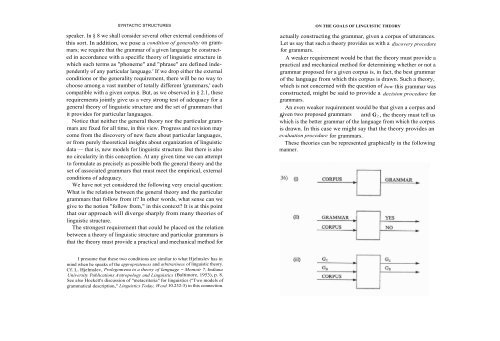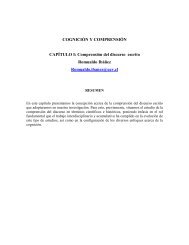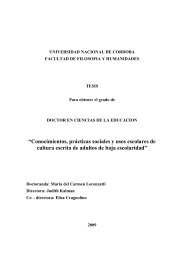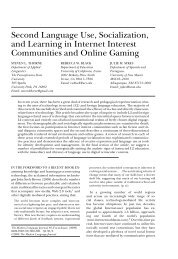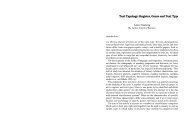Syntactic Structures
Syntactic Structures
Syntactic Structures
Create successful ePaper yourself
Turn your PDF publications into a flip-book with our unique Google optimized e-Paper software.
SYNTACTIC STRUCTURES<br />
speaker. In § 8 we shall consider several other external conditions of<br />
this sort. In addition, we pose a condition of generality on grammars;<br />
we require that the grammar of a given language be constructed<br />
in accordance with a specific theory of linguistic structure in<br />
which such terms as "phoneme" and "phrase" are defined independently<br />
of any particular language.' If we drop either the external<br />
conditions or the generality requirement, there will be no way to<br />
choose among a vast number of totally different 'grammars,' each<br />
compatible with a given corpus. But, as we observed in § 2.1, these<br />
requirements jointly give us a very strong test of adequacy for a<br />
general theory of linguistic structure and the set of grammars that<br />
it provides for particular languages.<br />
Notice that neither the general theory nor the particular grammars<br />
are fixed for all time, in this view. Progress and revision may<br />
come from the discovery of new facts about particular languages,<br />
or from purely theoretical insights about organization of linguistic<br />
data — that is, new models for linguistic structure. But there is also<br />
no circularity in this conception. At any given time we can attempt<br />
to formulate as precisely as possible both the general theory and the<br />
set of associated grammars that must meet the empirical, external<br />
conditions of adequacy.<br />
We have not yet considered the following very crucial question:<br />
What is the relation between the general theory and the particular<br />
grammars that follow from it? In other words, what sense can we<br />
give to the notion "follow from," in this context? It is at this point<br />
that our approach will diverge sharply from many theories of<br />
linguistic structure.<br />
The strongest requirement that could be placed on the relation<br />
between a theory of linguistic structure and particular grammars is<br />
that the theory must provide a practical and mechanical method for<br />
I presume that these two conditions are similar to what Hjelmslev has in<br />
mind when he speaks of the appropriateness and arbitrariness of linguistic theory.<br />
Cf. L. Hjelmslev, Prolegomena to a theory of language = Memoir 7, Indiana<br />
University Publications Antropology and Linguistics (Baltimore, 1953), p. 8.<br />
See also Hockett's discussion of "metacriteria" for linguistics ("Two models of<br />
grammatical description," Linguistics Today, Word 10.232-3) in this connection.<br />
ON THE GOALS OF LINGUISTIC THEORY<br />
actually constructing the grammar, given a corpus of utterances.<br />
Let us say that such a theory provides us with a discovery procedure<br />
for grammars.<br />
A weaker requirement would be that the theory must provide a<br />
practical and mechanical method for determining whether or not a<br />
grammar proposed for a given corpus is, in fact, the best grammar<br />
of the language from which this corpus is drawn. Such a theory,<br />
which is not concerned with the question of how this grammar was<br />
constructed, might be said to provide a decision procedure for<br />
grammars.<br />
An even weaker requirement would be that given a corpus and<br />
given 1 two proposed grammars and GG2<br />
, the theory must tell us<br />
which is the better grammar of the language from which the corpus<br />
is drawn. In this case we might say that the theory provides an<br />
evaluation procedure for grammars.<br />
These theories can be represented graphically in the following<br />
manner.


